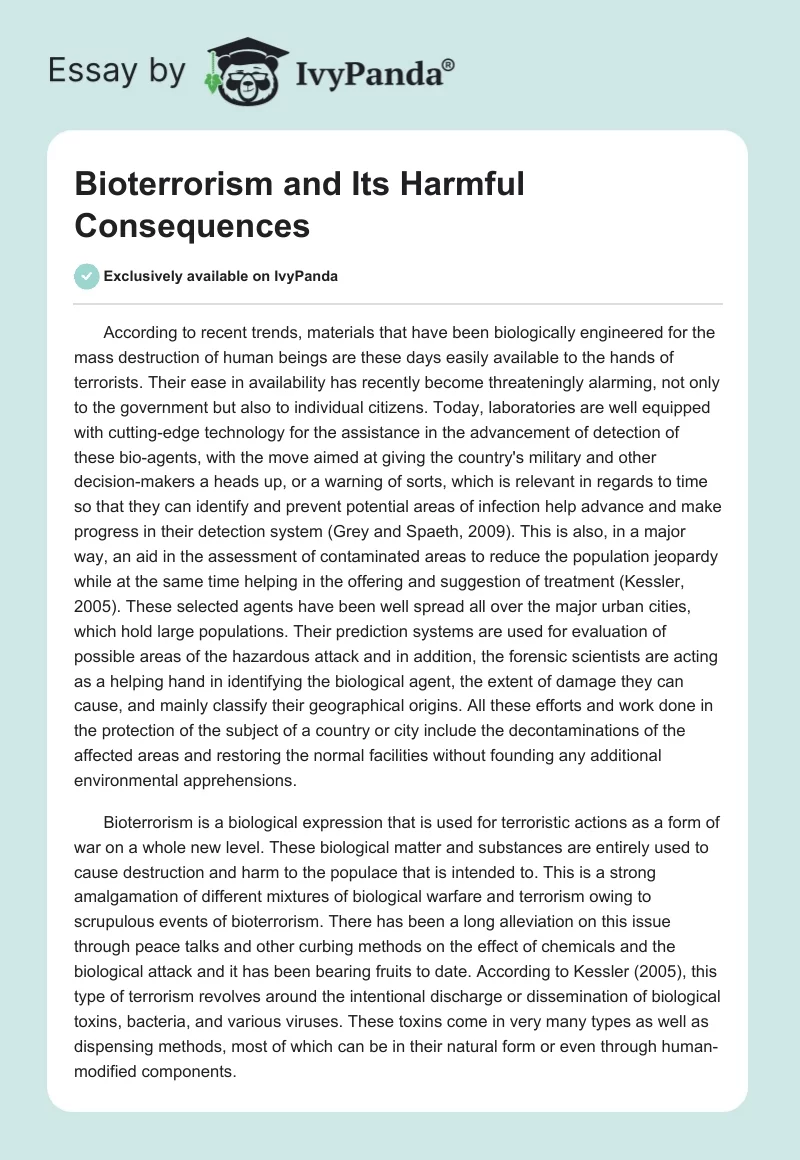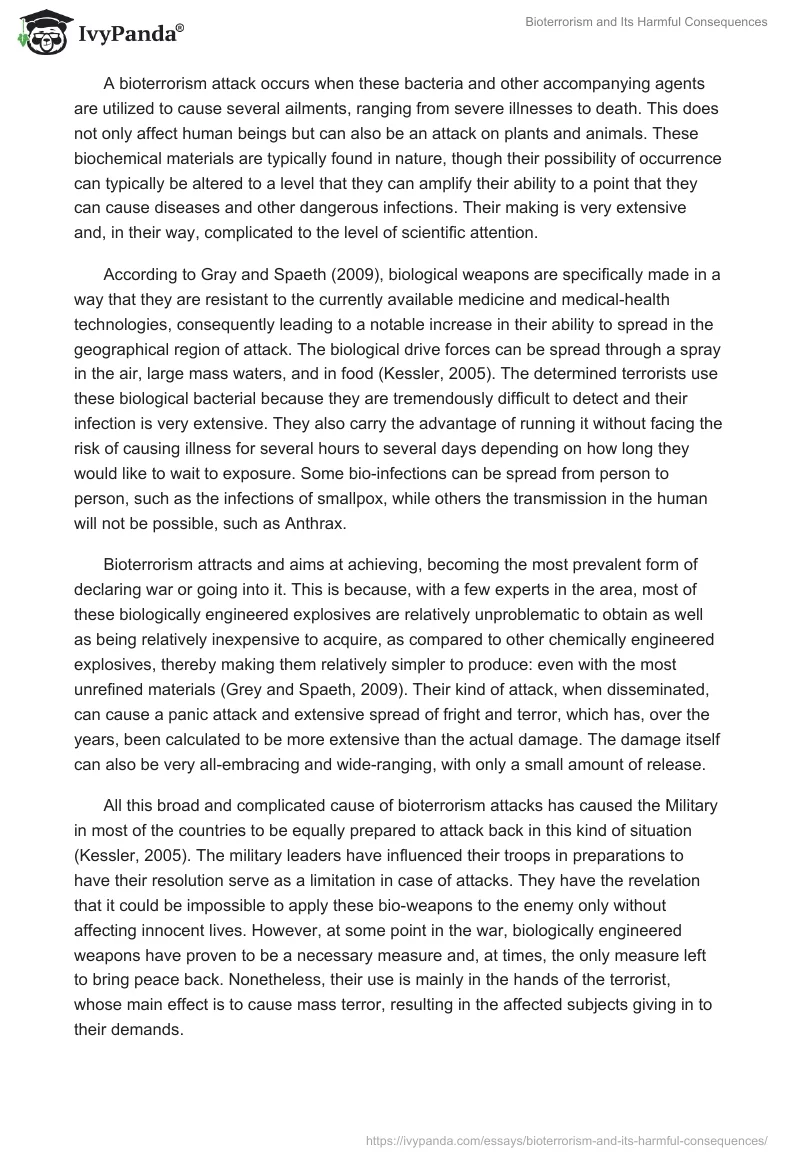According to recent trends, materials that have been biologically engineered for the mass destruction of human beings are these days easily available to the hands of terrorists. Their ease in availability has recently become threateningly alarming, not only to the government but also to individual citizens. Today, laboratories are well equipped with cutting-edge technology for the assistance in the advancement of detection of these bio-agents, with the move aimed at giving the country’s military and other decision-makers a heads up, or a warning of sorts, which is relevant in regards to time so that they can identify and prevent potential areas of infection help advance and make progress in their detection system (Grey and Spaeth, 2009). This is also, in a major way, an aid in the assessment of contaminated areas to reduce the population jeopardy while at the same time helping in the offering and suggestion of treatment (Kessler, 2005). These selected agents have been well spread all over the major urban cities, which hold large populations. Their prediction systems are used for evaluation of possible areas of the hazardous attack and in addition, the forensic scientists are acting as a helping hand in identifying the biological agent, the extent of damage they can cause, and mainly classify their geographical origins. All these efforts and work done in the protection of the subject of a country or city include the decontaminations of the affected areas and restoring the normal facilities without founding any additional environmental apprehensions.
Bioterrorism is a biological expression that is used for terroristic actions as a form of war on a whole new level. These biological matter and substances are entirely used to cause destruction and harm to the populace that is intended to. This is a strong amalgamation of different mixtures of biological warfare and terrorism owing to scrupulous events of bioterrorism. There has been a long alleviation on this issue through peace talks and other curbing methods on the effect of chemicals and the biological attack and it has been bearing fruits to date. According to Kessler (2005), this type of terrorism revolves around the intentional discharge or dissemination of biological toxins, bacteria, and various viruses. These toxins come in very many types as well as dispensing methods, most of which can be in their natural form or even through human-modified components.
A bioterrorism attack occurs when these bacteria and other accompanying agents are utilized to cause several ailments, ranging from severe illnesses to death. This does not only affect human beings but can also be an attack on plants and animals. These biochemical materials are typically found in nature, though their possibility of occurrence can typically be altered to a level that they can amplify their ability to a point that they can cause diseases and other dangerous infections. Their making is very extensive and, in their way, complicated to the level of scientific attention.
According to Gray and Spaeth (2009), biological weapons are specifically made in a way that they are resistant to the currently available medicine and medical-health technologies, consequently leading to a notable increase in their ability to spread in the geographical region of attack. The biological drive forces can be spread through a spray in the air, large mass waters, and in food (Kessler, 2005). The determined terrorists use these biological bacterial because they are tremendously difficult to detect and their infection is very extensive. They also carry the advantage of running it without facing the risk of causing illness for several hours to several days depending on how long they would like to wait to exposure. Some bio-infections can be spread from person to person, such as the infections of smallpox, while others the transmission in the human will not be possible, such as Anthrax.
Bioterrorism attracts and aims at achieving, becoming the most prevalent form of declaring war or going into it. This is because, with a few experts in the area, most of these biologically engineered explosives are relatively unproblematic to obtain as well as being relatively inexpensive to acquire, as compared to other chemically engineered explosives, thereby making them relatively simpler to produce: even with the most unrefined materials (Grey and Spaeth, 2009). Their kind of attack, when disseminated, can cause a panic attack and extensive spread of fright and terror, which has, over the years, been calculated to be more extensive than the actual damage. The damage itself can also be very all-embracing and wide-ranging, with only a small amount of release.
All this broad and complicated cause of bioterrorism attacks has caused the Military in most of the countries to be equally prepared to attack back in this kind of situation (Kessler, 2005). The military leaders have influenced their troops in preparations to have their resolution serve as a limitation in case of attacks. They have the revelation that it could be impossible to apply these bio-weapons to the enemy only without affecting innocent lives. However, at some point in the war, biologically engineered weapons have proven to be a necessary measure and, at times, the only measure left to bring peace back. Nonetheless, their use is mainly in the hands of the terrorist, whose main effect is to cause mass terror, resulting in the affected subjects giving in to their demands.
Any case of early detection followed by an expert response to the bio-weapons could be a saving situation for the people and the country itself, at large. All this will only closely rely on the security cooperation lying among the community, the public health system, and law enforcement to have a successful outcome and consent to the prevailing peace. In the case that this co-operation is missing, the detection system will lose its chief meaning and the vaccine stockpiles will consequently not be useful to the locals.
References
Grey, R.M. & Spaeth, K. S. (2009). The physician’s guide to depression and bipolar disorders. New York: McGraw-Hill.
Kessler, G.C. (2005). Bioterrorism: mathematical modeling applications in homeland security. New Jersey, NJ: Wizard Books.


